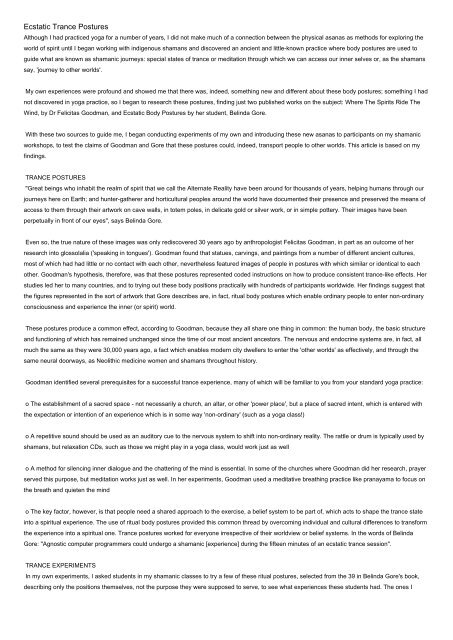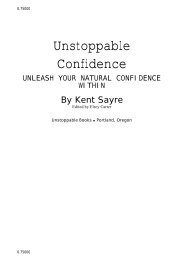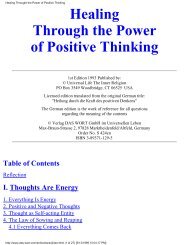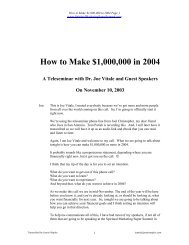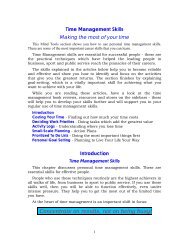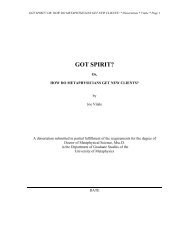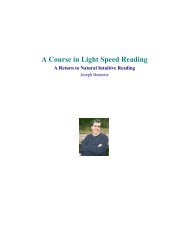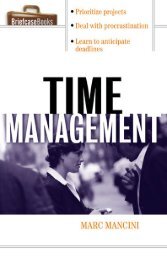Ecstatic Trance Postures - Motivational Magic
Ecstatic Trance Postures - Motivational Magic
Ecstatic Trance Postures - Motivational Magic
You also want an ePaper? Increase the reach of your titles
YUMPU automatically turns print PDFs into web optimized ePapers that Google loves.
<strong>Ecstatic</strong> <strong>Trance</strong> <strong>Postures</strong><br />
Although I had practiced yoga for a number of years, I did not make much of a connection between the physical asanas as methods for exploring the<br />
world of spirit until I began working with indigenous shamans and discovered an ancient and little-known practice where body postures are used to<br />
guide what are known as shamanic journeys: special states of trance or meditation through which we can access our inner selves or, as the shamans<br />
say, 'journey to other worlds'.<br />
My own experiences were profound and showed me that there was, indeed, something new and different about these body postures; something I had<br />
not discovered in yoga practice, so I began to research these postures, finding just two published works on the subject: Where The Spirits Ride The<br />
Wind, by Dr Felicitas Goodman, and <strong>Ecstatic</strong> Body <strong>Postures</strong> by her student, Belinda Gore.<br />
With these two sources to guide me, I began conducting experiments of my own and introducing these new asanas to participants on my shamanic<br />
workshops, to test the claims of Goodman and Gore that these postures could, indeed, transport people to other worlds. This article is based on my<br />
findings.<br />
TRANCE POSTURES<br />
"Great beings who inhabit the realm of spirit that we call the Alternate Reality have been around for thousands of years, helping humans through our<br />
journeys here on Earth; and hunter-gatherer and horticultural peoples around the world have documented their presence and preserved the means of<br />
access to them through their artwork on cave walls, in totem poles, in delicate gold or silver work, or in simple pottery. Their images have been<br />
perpetually in front of our eyes", says Belinda Gore.<br />
Even so, the true nature of these images was only rediscovered 30 years ago by anthropologist Felicitas Goodman, in part as an outcome of her<br />
research into glossolalia ('speaking in tongues'). Goodman found that statues, carvings, and paintings from a number of different ancient cultures,<br />
most of which had had little or no contact with each other, nevertheless featured images of people in postures with which similar or identical to each<br />
other. Goodman's hypothesis, therefore, was that these postures represented coded instructions on how to produce consistent trance-like effects. Her<br />
studies led her to many countries, and to trying out these body positions practically with hundreds of participants worldwide. Her findings suggest that<br />
the figures represented in the sort of artwork that Gore describes are, in fact, ritual body postures which enable ordinary people to enter non-ordinary<br />
consciousness and experience the inner (or spirit) world.<br />
These postures produce a common effect, according to Goodman, because they all share one thing in common: the human body, the basic structure<br />
and functioning of which has remained unchanged since the time of our most ancient ancestors. The nervous and endocrine systems are, in fact, all<br />
much the same as they were 30,000 years ago, a fact which enables modern city dwellers to enter the 'other worlds' as effectively, and through the<br />
same neural doorways, as Neolithic medicine women and shamans throughout history.<br />
Goodman identified several prerequisites for a successful trance experience, many of which will be familiar to you from your standard yoga practice:<br />
o The establishment of a sacred space - not necessarily a church, an altar, or other 'power place', but a place of sacred intent, which is entered with<br />
the expectation or intention of an experience which is in some way 'non-ordinary' (such as a yoga class!)<br />
o A repetitive sound should be used as an auditory cue to the nervous system to shift into non-ordinary reality. The rattle or drum is typically used by<br />
shamans, but relaxation CDs, such as those we might play in a yoga class, would work just as well<br />
o A method for silencing inner dialogue and the chattering of the mind is essential. In some of the churches where Goodman did her research, prayer<br />
served this purpose, but meditation works just as well. In her experiments, Goodman used a meditative breathing practice like pranayama to focus on<br />
the breath and quieten the mind<br />
o The key factor, however, is that people need a shared approach to the exercise, a belief system to be part of, which acts to shape the trance state<br />
into a spiritual experience. The use of ritual body postures provided this common thread by overcoming individual and cultural differences to transform<br />
the experience into a spiritual one. <strong>Trance</strong> postures worked for everyone irrespective of their worldview or belief systems. In the words of Belinda<br />
Gore: "Agnostic computer programmers could undergo a shamanic [experience] during the fifteen minutes of an ecstatic trance session".<br />
TRANCE EXPERIMENTS<br />
In my own experiments, I asked students in my shamanic classes to try a few of these ritual postures, selected from the 39 in Belinda Gore's book,<br />
describing only the positions themselves, not the purpose they were supposed to serve, to see what experiences these students had. The ones I
chose were:<br />
o The Tattooed Jaguar, dating from Mexico, circa 1400 BC, which is considered a shapeshifting posture that gives us a view of reality from the<br />
perspective of a Big Cat. Through it, in Gore's words, "many individuals become sensitised to the non-human world and grow in rapport with the<br />
animals".<br />
o The Tennessee Diviner, dating from Europe circa AD 700, is a divinatory posture which puts people in touch with a spirit who offers advice on ritual.<br />
This spirit can be "short tempered, brief and even cryptic" but is "generous with exacting details" concerning specific healing rituals.<br />
o The Realm of the Dead posture, from fifth century BC Germany, mediates journeys into the spirit world, where "The traveller... begins to rise into a<br />
new form and a new life".<br />
So you can, if you wish, try these postures for yourself, here are the instructions:<br />
The Tattooed Jaguar<br />
Kneel with your legs spread so your knees form a 'V' and your right big toe crosses over the left big toe. Rest your buttocks on your heels and bend<br />
forward slightly at the waist.<br />
Curl your hands the amount needed to hold an imaginary medium-sized candle. Place your curled left hand palm down on your left knee and your<br />
right hand on your right knee, tilted upwards slightly (so if you were actually holding a candle, it would point at 45 degrees towards your other leg).<br />
Keep your elbows relaxed and slightly bow your arms. Face forward with eyes closed.<br />
The Tennessee Diviner<br />
Begin by kneeling, then raise your right knee and place your right foot sole down on the floor beside your left knee. Continue to kneel on your left<br />
knee, with buttocks resting on your heel.<br />
Place your left hand palm down on the left knee and right hand palm down on the right knee, but slightly to the left of the kneecap.<br />
Cock your head very slightly to the right as if wanting to look over your right knee. Keep your eyes closed and protrude your tongue a little between<br />
slightly parted lips.<br />
The Realm of the Dead<br />
Stand with feet parallel about 6 inches apart and point your toes straight ahead. Keep your knees slightly bent.<br />
Place your right hand over your waist with the ball of the hand covering your navel and your middle finger extending along the waistline. Your left arm<br />
is against your chest, with the palm of the hand against your chest so it rests just above your right arm and parallel to it. Keep your upper arms relaxed<br />
and close to your body. Face forward with your eyes closed.<br />
RESULTS<br />
My students all reported markedly different effects to the ones normally experienced using standard approaches to meditation or shamanic<br />
journeying. "Each individual was successful in gaining a different perspective than normal and in terms of where they went spiritually, the journeys<br />
were intense", said one workshop participant who also introduced the postures to her yoga group.<br />
The Realm of the Dead posture (described to my students only as the 'RoD', so as not to disclose its purpose) produced a characteristic meeting with<br />
"spirit guides", this yoga teacher continued. Another of my participants, who could only hold this posture for a short time due to a prior injury,<br />
commented: "I got an impression of the incredible vastness of time and space rushing towards me, as if I was travelling at a very fast rate of speed<br />
through space. I saw blackness and stars that were very far away from me... I didn't think I really got anything in that short time, but since you asked<br />
specifically, I realise I did - and the impression is staying with me".<br />
The most intense of all postures was the Tattooed Jaguar, a shapeshifting posture for experiencing reality through the eyes of a cat. "I journeyed in<br />
this posture and met the 'Mother Jaguar'", said one student. "It was incredible. I was fully grown but compared to the size of the mother, I was a six<br />
week old kitten".
The Tennessee Diviner (described to students as 'Tennessee D') - a divinatory posture, as the name suggests - on the other hand, had a more limited<br />
effect. In retrospect, this is not so surprising. The essence of divination is to hold a question in mind during the journey and without knowing the<br />
purpose of the posture, this was impossible. Students mentioned only an "intense experience" and a feeling of "lightness".<br />
I wonder how your own results compare.<br />
CONCLUSION<br />
It seems clear from the experiences of students, and from Goodman's own research, that these postures do produce qualitatively different<br />
experiences to those normally found in meditative practice, that each posture was different in itself from others, and that the effects experienced are<br />
consistent with the findings of Goodman and Gore.<br />
Some postures by their very nature do seem to open a specific doorway to particular otherworldly territories or states of being, and if this is so, our<br />
distant ancestors had access to a vast knowledge that we can only guess at today - although practice may help us get closer to their experiences and<br />
to their knowledge of other realms.<br />
THE AUTHOR<br />
Ross Heaven is a workshop leader and the author eight books on spiritual wisdom, shamanism, and healing, including Love's Simple Truths:<br />
Meditations on Rumi and The Path of The Heart, Plant Spirit Shamanism: Traditional Techniques for Healing the Soul, and The Spiritual Practices of<br />
the Ninja. He has a website at www.thefourgates.com.<br />
BOOKS MENTIONED IN THIS ARTICLE<br />
Belinda Gore, <strong>Ecstatic</strong> Body <strong>Postures</strong><br />
Felicitas D Goodman, Where The Spirits Ride The Wind: <strong>Trance</strong> Journeys And Other <strong>Ecstatic</strong> Experiences<br />
About the Author<br />
Ross Heaven is a therapist, workshop leader, and the author of several books on shamanism and healing, including Darkness Visible, the best-selling<br />
Plant Spirit Shamanism, and Love's Simple Truths. His website is http://www.thefourgates.com where you can also read how to join his sacred<br />
journeys to the shamans and healers of the Amazon.<br />
Source: http://www.motivationalmagic.com


